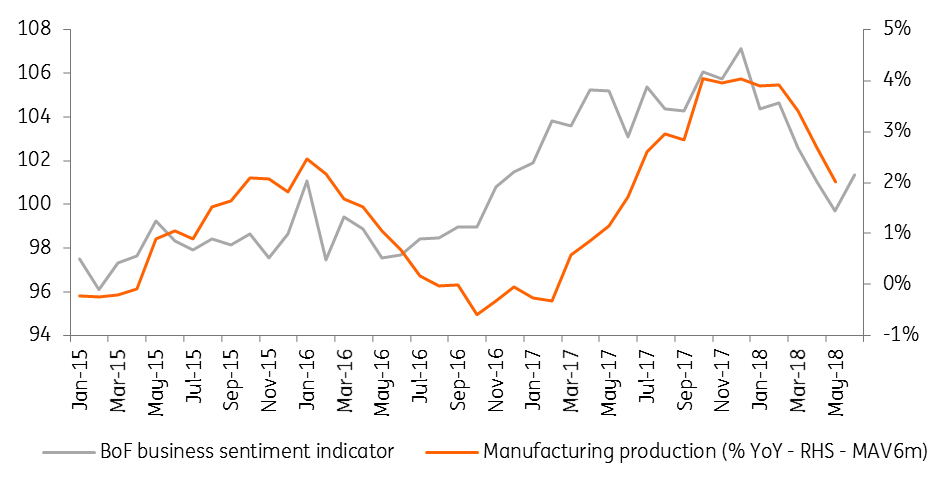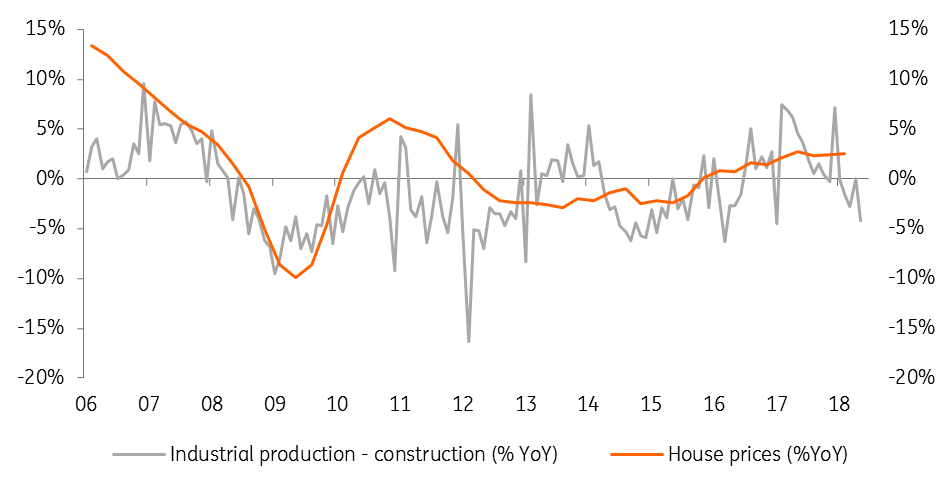French construction activity points to a housing cycle soft landing
French industrial production declined slightly in May, reflecting the current slowdown in consumption and investments. A drop off in construction could be a sign of a turning housing market cycle, but the rest of the year is still looking good
| -0.2% |
Industrial production drop in May |
| Lower than expected | |
Manufacturing production seems to have peaked
Industrial production declined by 0.2% MoM in May, showing a strong deceleration on the year (from 2% to -0.9%). Only energy production rebounded by 1.1%, all other production indicators contracted. Manufacturing production dropped by 0.6%, in particular, durable consumer goods (-1.7%) and investment goods (-0.8%) while activity in the construction sector dropped by 3.4%.
Overall, the May reading is well below expectations. Production of investment goods was in May 2.2% below its peak of 4Q17, reflecting a lower level of investment by non-financial companies, which already showed in 1Q18 GDP figures and is likely to be repeated in the second quarter. The situation is even worse for durable consumer goods, of which production is now 4.2% below its 4Q17 peak, also reflecting weak consumer spending. This indicates that the weaker figures registered in 1Q18 private consumption and corporate investments GDP figures could be repeated in the second quarter. If that were to be the case, it is unlikely that we could maintain our current forecast of 2% GDP growth in 2018.
There are signs of stabilisation though, mostly in recent surveys which show that, if sentiment is not as bullish as at the end of 2017, pessimism is not yet there, at least compared to where it was only 18 months ago. Business sentiment rebounded in June, indicating that the current downward trend in manufacturing production growth could stabilise at around 2% YoY.
Manufacturing production should stabilise, but the rebound has been short

The outlook is still positive
In particular, order books remain at record levels, especially for intermediate goods, the production of which increased in May, although by a weak 0.1%. We still believe the second half of 2018 could be stronger than the first. It could prove insufficient to lift GDP growth above 2% in 2018 but would certainly be a sign that the current phase of the cycle is not yet over. In our view, the second half of the year could still benefit from relatively high sentiment levels and from the abating negative effects of strikes. This should not hide the fact that the 2017 rebound will have been short-lived: industrial production has been growing at a rate of 1.6% YoY so far this year, down from 3.5% in the second half of 2017.
Construction activity continues to slow down: a turn in the housing market?

Low construction activity could be the sign of a turning housing market cycle
Construction activity, which grew by 2.8% in 2017, has been slowing down sharply in 2018 (-1.7% YoY so far). This had been confirmed by households’ investment growth in 1Q18 GDP figures (they increased by a mere 0.2% QoQ, their lowest rate since 2015). While this sector has been recovering since 2015, we see there the first signs of an end of the cycle on the housing market. As long as interest rates remain supportive, we do not believe in a hard landing, but May construction activity figures are a sign that the housing market could be cooling down somewhat. Activity declined by 3.4% in May and was as low as two years ago. If this were to be confirmed after the summer, we could see house price growth slowing down in the last months of the year.
Download
Download article"THINK Outside" is a collection of specially commissioned content from third-party sources, such as economic think-tanks and academic institutions, that ING deems reliable and from non-research departments within ING. ING Bank N.V. ("ING") uses these sources to expand the range of opinions you can find on the THINK website. Some of these sources are not the property of or managed by ING, and therefore ING cannot always guarantee the correctness, completeness, actuality and quality of such sources, nor the availability at any given time of the data and information provided, and ING cannot accept any liability in this respect, insofar as this is permissible pursuant to the applicable laws and regulations.
This publication does not necessarily reflect the ING house view. This publication has been prepared solely for information purposes without regard to any particular user's investment objectives, financial situation, or means. The information in the publication is not an investment recommendation and it is not investment, legal or tax advice or an offer or solicitation to purchase or sell any financial instrument. Reasonable care has been taken to ensure that this publication is not untrue or misleading when published, but ING does not represent that it is accurate or complete. ING does not accept any liability for any direct, indirect or consequential loss arising from any use of this publication. Unless otherwise stated, any views, forecasts, or estimates are solely those of the author(s), as of the date of the publication and are subject to change without notice.
The distribution of this publication may be restricted by law or regulation in different jurisdictions and persons into whose possession this publication comes should inform themselves about, and observe, such restrictions.
Copyright and database rights protection exists in this report and it may not be reproduced, distributed or published by any person for any purpose without the prior express consent of ING. All rights are reserved.
ING Bank N.V. is authorised by the Dutch Central Bank and supervised by the European Central Bank (ECB), the Dutch Central Bank (DNB) and the Dutch Authority for the Financial Markets (AFM). ING Bank N.V. is incorporated in the Netherlands (Trade Register no. 33031431 Amsterdam).